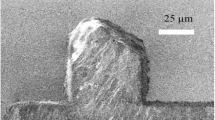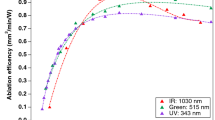Abstract
Removal of bulk dental hard tissue is carried out conventionally using burrs and turbine handpieces. This paper reports on the use of excimer laser radiation in the production of tunnel preparations to access deep caries. Using energy densities which were calculated to produce a clinically acceptable rate of tissue removal, extracted human teeth were irradiated. Both enamel and dentine were subjected to numbers of pulses ranging from 500 to 2500 with an energy per pulse of 15 J cm−2. The cross-section and depth of the lesions produced were measured using the Reflex microscope. The results showed that the ablation for dentine appears to be relatively constant while there is a gradual reduction in ablation rate in enamel as the depth increases. This may be attributable to the interaction between the plume of debris and the laser beam.
Similar content being viewed by others
References
Paterson RC, Watts A. The dentine smear layer and bonding agents.Rest Dent 1990,6:19–25
Nelson DGA, Jongebloed WL, Featherstone JDB. Laser irradiation of human dental enamel and entine.N Z Dent J 1986,82:74–7
Wigdor H, Elliott ABT, Ashrafi S, Walsh J. Effect of lasers on dental hard tissue.J Am Dent Assoc 1993,124:65–70
Srinivasan R. Ablation of polymers and biological tisue by ultraviolet lasers.Science 1986,234:599–665
Cox CJM, Patel BCM, Pearson GJ. An experimental evaluation of precision laser cutting of dental hard tissues and materials.Eur J Prosthodont Rest Dent 1993,1:179–84
Moss J, Patel BCM, Pearson GJ Krypton fluoride excimer laser ablation of tooth tissue: precision tissue machining.Biomaterials (in press)
Frentzen M, Koort H-J, Thiensiri I. Excimer lasers in dentistry: future possibilities with advanced technology.Quintessence Int 1992,23: 117–33
Sutcliffe E. Srinivasan R. Dynamics of UV laser ablation of organic polymer surfaces.J Appl Physiol 1986,60:3315–22
Hame H, Voss R Papioannou T et al. The effect of 308 nm excimer laser on tooth dentine.SPIE: Laser Surgery: Advanced Characterisation, Therapeutics and Systems II 1990,200:452–8
Neev J Lih-Huei L, Raney D et al. Selectivity, efficiency and surface characteristics of the dental tissues ablated with ArF pulsed excimer lasersLasers Surg Med 1991,11:499–510
Author information
Authors and Affiliations
Rights and permissions
About this article
Cite this article
Patel, B.C.M., Moss, J. & Pearson, G.J. Excimer laser (248 nm) drilling of tooth tissue: Preliminary investigation. Laser Med Sci 9, 243–248 (1994). https://doi.org/10.1007/BF02593886
Received:
Issue Date:
DOI: https://doi.org/10.1007/BF02593886




